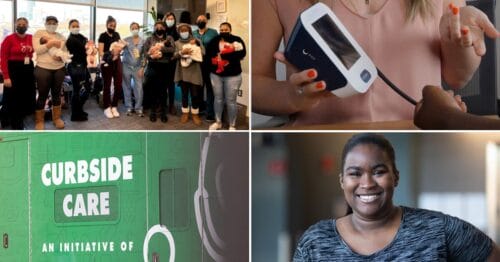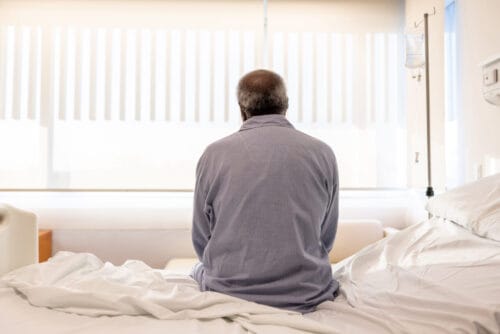New Intervention Addresses Racial Disparities in Uterine Fibroid Care and Treatment
July 21, 2022

JGI/Tom Grill, Getty Images
Fibroid Center aims to empower and educate Black patients through new interventions and tools
Uterine fibroids are a common health problem — as many as 80% of people with a uterus develop these uterine masses before they turn 50. Fibroids can cause severe bleeding, debilitating pain, anemia, infertility, and complications during pregnancy and delivery. While not all fibroids cause symptoms, for those with symptomatic fibroids, the condition can have a deep impact on every aspect of their life, from work and school to mental health and fertility.
Though anyone with a uterus can have fibroids, they are of special concern for Black patients, who are two to three times more likely than white patients to have fibroids, experience larger and more numerous fibroids, have more severe symptoms, and be diagnosed at an earlier age. And yet, many Black people with fibroids feel that their symptoms are not taken seriously or that they are not empowered to take an active role in their treatment.
Disparities in fibroid care and treatment
In addition, implicit racial bias within the healthcare system has been directly linked to delivery of lower quality care for Black patients. This bias can affect whether a Black patient decides to seek care for their fibroids, how their providers perceive their pain and symptoms, and the potential treatments they are offered.
Black patients also face disparities in treatment utilization and outcomes, including being more likely to undergo invasive procedures than women of other races, including hysterectomy. One large study found that Black patients are 45% less likely to undergo a minimally invasive hysterectomy after adjusting for other characteristics and potential confounders. This disparity in treatment is concerning because minimally invasive surgery offers the benefits of faster recovery, less pain, decreased risk of infection, and lower risk of venous thromboembolism (VTE) compared with traditional surgical methods.
Taking a stand against health inequity
In an effort to combat this health inequity, we have recently established the Fibroid Center at Boston Medical Center (BMC) to provide multidisciplinary, patient-centered, and evidence-based care to our patients with fibroids. Our team of gynecologists, reproductive endocrinology and infertility specialists, interventional radiologists, midwives and hematologists work with closely as a team to provide all patients with holistic care and treatment for their fibroids.
Through the center, we have brought new treatment options to patients and conducted retrospective studies of our patients to better understand the population and develop future interventions. We’ve also created a stakeholder group that includes members of our team and patient advocates that meets quarterly to discuss how to improve clinical care and clinical navigation of care, including referring patients for imaging studies, iron infusions, hematology, and interventional radiology.
As part of our mission, we recently developed and launched an interactive Fibroid Treatment Tool to help patients learn more about their treatment options based on their symptoms and fertility status.
New patient-centered education program launches
In January 2022, our team launched an intervention called Centering(patientswith)Fibroids (CPWF), a 10-week education and empowerment program specifically for Black patients diagnosed with uterine fibroids. The concept was adapted from the Centering Healthcare Institute’s programmatic features and group care model which was designed to engage and empower patient participants, with the end goal of improving patient knowledge, understanding of their health condition, and available treatment options. CenteringPregnancy has been shown to improve maternal and fetal outcomes and our aim is that this model will improve outcomes for patients with uterine fibroids.
For the pilot program, we recruited 10 patients from our clinic between the ages of 25 and 45, who were similar in terms of reproductive age and fertility goals. Six of the 10 participants attended a majority of sessions. Each week covered a different topic with appropriate specialists, covering the basics of uterine fibroids, symptoms, mental health, pregnancy and fertility, ancestral or integrative medicine, medical therapies, and surgical options including both uterine sparing procedures and hysterectomy. In addition, participants were able to meet community stakeholders and participate in short mindfulness sessions.
Collaborating with community partners
In developing the curriculum for the program, we collaborated with The White Dress Project, a national patient advocacy organization that raises awareness of fibroids, and the Resilient Sisterhood Project, founded in 2012, which is a local organization that focuses on reproductive justice issues that disproportionately impact women of African descent through education and empowerment. Along with education, The White Dress Project advocates for research funding, highlights reproductive health inequities and empowers their community to make the best health decisions for themselves and their bodies. The Resilient Sisterhood Project’s core programming includes community outreach, and the way reproductive justice intersects with incarceration, environmental justice, and immigration.
Preliminary data from our first cohort showed that participants felt supported and empowered by this group model of care. In their feedback, participants noted the openness of the group experience and appreciation for the tools and information to make more informed decisions about their treatment. As one participant noted: “This was a great opportunity to not only learn about fibroids itself, but more about myself and decisions I make for my body.”
A public health issue
Moving forward, one of our goals is to help people view fibroids as a public health issue. When we think about its impact on quality of life and time away from work, it’s imperative to put the time and energy into policies to increase funding for research, such as the Stephanie Tubbs Jones Uterine Fibroid Research and Education Act of 2021, which is currently in the Senate and House and, if passed, would allocate $150 million to the National Institutes of Health (NIH) over 5 years for research, a public education program and data collection on populations most impacted by uterine fibroids.


